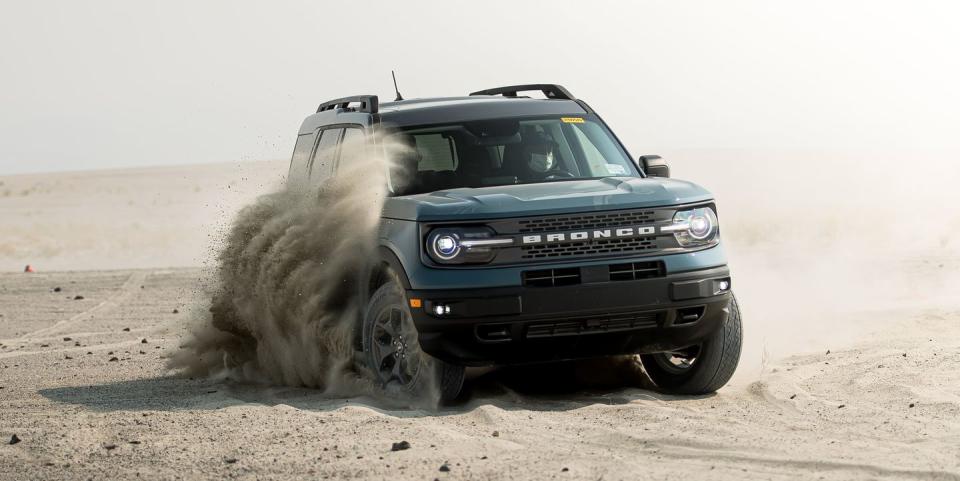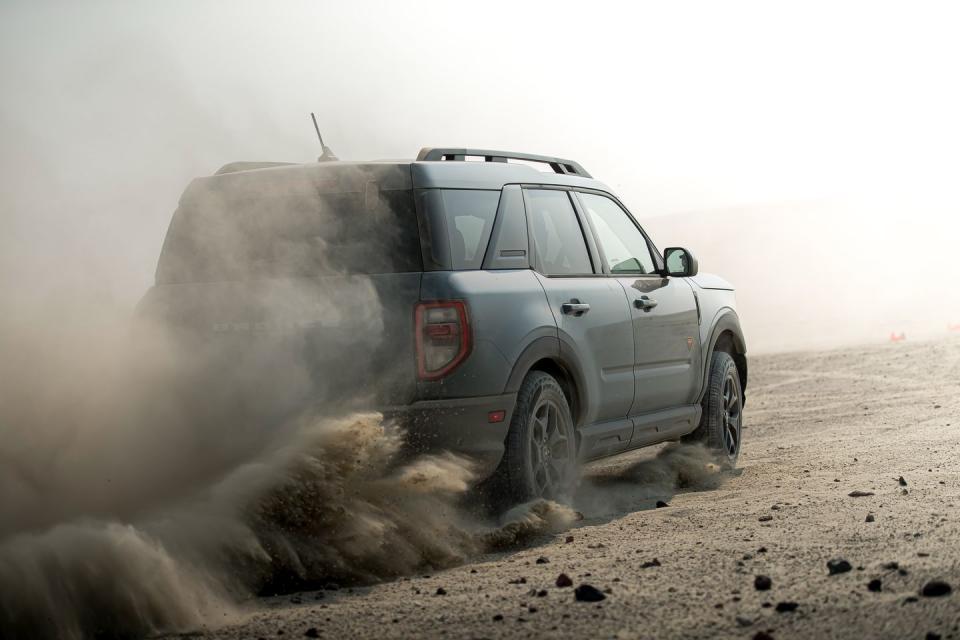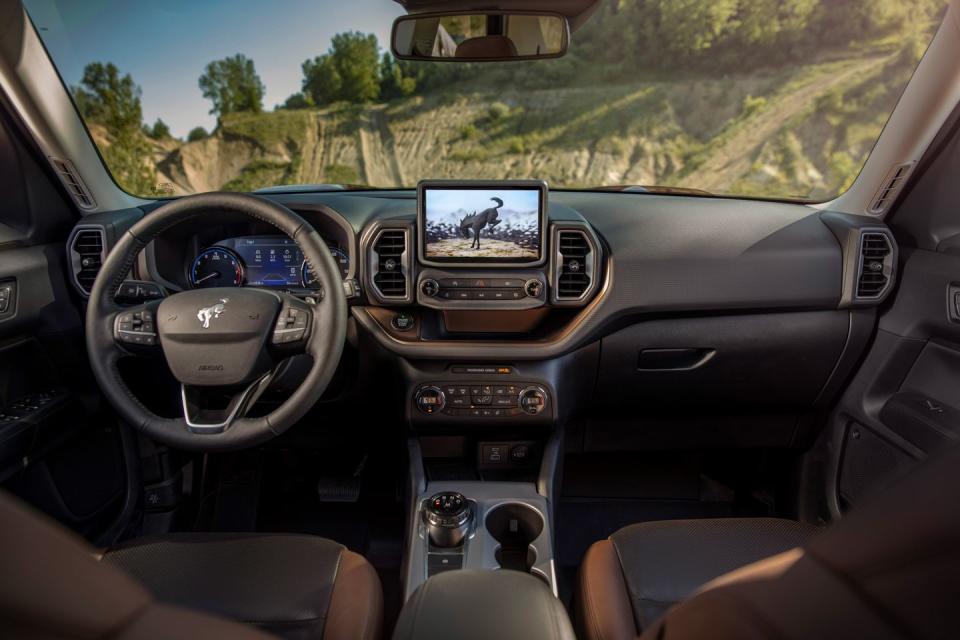Tested: 2021 Ford Bronco Sport Badlands Earns the Bronco Name

UPDATE 2/11/21: This review has been updated with test results.
A United States Navy F/A-18E Super Hornet has crashed up ahead during a routine training mission. The remains of the fighter jet, flying out of Naval Air Station Lemoore, lie smoldering in the California desert. All traffic has been stopped. But before the California Highway Patrol officer blocking the road tells us that the pilot ejected in time and should be fine, the 2021 Ford Bronco Sport Badlands captures his attention. "Wow, is this the new Ford Bronco?" he asks.
He isn't the first to confuse the new Bronco's baby brother for the real deal since we left Los Angeles earlier in the day. We assume all the people in Jeep Wranglers and lifted pickups who were shooting video of us on the freeway were making the same mistake. Maybe it's the giant BRONCO lettering emblazoned across its grille and liftgate; the word SPORT only appears once between its taillights, and even then it's small. Following at a distance greater than about three car lengths, the only part that's readable is Bronco. We don't think this is an accident.

On the outside, both Ford SUVs ape the design elements from the original Broncos of the 1960s and '70s, yet the two are very dissimilar underneath. The full Bronco is a proper truck, a rival for the Wrangler with a ladder-type frame and a two-speed transfer case. Conversely, the Sport is built on Ford's C2 front-wheel-drive platform, which underpins the compact Escape, and it's designed to compete with car-based crossovers such as the Jeep Compass and Cherokee. But the Bronco Sport is no wimpy soft-roader, at least not in our test car's top-spec Badlands trim.
Equipped for Adventure
For the record, the Bronco Sport Badlands was named after South Dakota's Badlands National Park and its geologic formations, not the Bruce Springsteen song from 1978. Aside from a limited run of First Edition models, it's the most expensive of the Sport's five available trim levels and the best performer, both on and off road. At $34,315 to start, it costs $6000 more than the base model and brings a long list of upgrades. A turbocharged 2.0-liter inline-four with 250 horsepower and 277 pound-feet of torque resides under its hood, replacing the 181-hp turbocharged three-cylinder that powers the Base, Big Bend, and Outer Banks models. An eight-speed automatic transmission is standard across the board.
Badlands models also get unique suspension tuning with about an inch more ground clearance than lesser trims. To cope with the additional weight of the four-cylinder, taller and slightly stiffer springs are fitted, as are front dampers with hydraulic rebound stops for soaking up harsh, full-jounce impacts. Ford claims that the Badlands's 7.4 inches of wheel travel is the best in its class. With 8.8 inches of ground clearance, the Badlands has a hair more clearance than a Jeep Cherokee Trailhawk. To gain a few extra millimeters of space, Ford's engineers tucked the Sport's exhaust system up closer to the floorpan. Its 30.4-degree approach angle is also better than the Jeep's, although the Cherokee offers slightly better breakover and departure angles.

All-wheel drive is standard on all Bronco Sports, but the Badlands features a torque-vectoring rear differential that borrows tech from the Focus RS. Its Terrain Management System also expands from five modes to seven, gaining Mud/Ruts and Rock Crawl settings. Although its dampers are passive units, the drive programs alter the tuning of the throttle, transmission, brake response, steering effort, and the all-wheel-drive system for the chosen conditions.
Also included on the Badlands are skid plates for the powertrain and fuel tank, an off-road cruise-control-like system that works up to 20 mph, a front-facing camera, front tow hooks, steering-wheel-mounted paddle shifters, and 28.5-inch-tall all-terrain tires. Pirelli Scorpio A/Ts are standard, but our test vehicle wore optional 235/65R-17 Falken WildPeaks, which cost $495 and are slightly wider, a half-inch taller, and have a more aggressive tread pattern. The knobby tires fill the Bronco Sport's wheel wells and come wrapped around 17-inch wheels that have a purposefully old-school look. Although they look like steelies, they're aluminum. We like them a lot. A Ford engineer tells us owners can upgrade to 30.5-inch tires without any clearance problems, but 31s won't fit without increasing the height of the suspension.
Even better, the tires' off-road credentials don't impede the Sport's on-road stopping ability. In our 70-mph-to-zero braking test, the Bronco came to a halt in a curt 163 feet. That beats everything but the Escape from our recent comparison test of six compact crossovers. Unfortunately, our Michigan skidpad was covered with snow, so we can't comment on the Falkens' lateral grip capability.

Balancing Comfort and Capability
Ford says it had this vehicle in mind when it designed its C2 platform, making additional reinforcement to the structure unnecessary. Torsional rigidity is the same as in the Escape, and it lends the Bronco Sport a solid feel. Making the Sport capable of safely fording nearly two feet of water required only slight modifications to the engine's air-intake plumbing and fitting more robust bottom door seals.
The Sport's 105.1-inch wheelbase is 1.6 inches shorter than the Escape's, which both improves its breakover angle and gives it a stockier stance. In the metal, its boxy silhouette, slab body sides, and muscular wheel-well flares give it presence, but it's smaller than it looks—8.0 inches shorter than the Escape and essentially the same size as the Jeep Compass except that the Bronco is six inches taller. Our only aesthetic complaint is the integration of its backup camera, which appears glued to the rear hatch as an afterthought.
The Bronco Sport feels bigger on the road than it is, thanks to its ample headroom, heavily weighted steering, and firm ride. It feels substantial and rather truck-like in how its suspension translates a significant amount of road texture to your backside. Highway expansion joints kick you up out of the seat.

Despite this truck-like feel, the Bronco Sport remains light—just two pounds heavier than an Escape 2.0T we tested—and quick. Lag from the turbo-four is negligible, and the transmission is well-tuned to deliver snappy kickdowns when you floor the accelerator and precise rev matching when flicking the paddle shifters. We clocked the Bronco's sprint to 60 mph at 5.9 seconds and its quarter-mile pass took 14.5 seconds—figures near the front of its competitive pack and just a couple tenths of a second shy of the last Escape we tested with this powertrain.
But the Bronco Sport's boxy shape does catch up to it in terms of fuel economy. On our 75-mph highway loop, we measured 24 mpg. That's 2 mpg below its EPA highway estimate and 8 mpg off of what a 2.0T Escape achieved in the same test.
In Its Element
You sit upright in the Bronco Sport and look out over a bulging hood, just like you do in the big Bronco. Its chunky interior design fits its rugged character, save for the rotary shift knob that carries over from the Escape. A conventional shift lever would be a better fit. At our test vehicle's $36,300 price, we also wish Ford had wrapped the steering wheel in leather, but it didn't. There are a bunch of other features missing, too, including dual-zone climate control, a heated steering wheel, a moonroof, separate front- and rear-height adjustments for the driver's seat, front and rear park assist, an auto-dimming rearview mirror, and a power liftgate. Many of those items are included in the $2595 Badlands package that our test vehicle didn't have. (We can only imagine the confusion that will be had at the dealership from having an option package with the same name as the trim level.)

But there are also features that set the Bronco Sport apart, such as the under-seat bin beneath the passenger's side rear seat and a bottle opener tucked into the liftgate opening. You never know when that will come in handy. Rear seat legroom is tight but sufficient. And for your muddy gear, a rubberized and textured cargo floor extends to the seatbacks. Transporting larger items is surprisingly easy. Ford says two mountain bikes can fit upright inside with the rear seats folded, and the Sport's rear window opens separately from the hatch.
Leave the pavement and the Bronco Sport Badlands feels more at home than it does on the interstate. Suddenly, its steering and suspension tuning are spot on as it soaks up washboard roads and ascends sand dunes as if they were suburban driveways. Sand mode makes good use of the torque-vectoring differential, allowing the Sport to be drifted like a rear driver. "We wanted it to be fast in the sand," says a Ford rep. Also, as we discovered during back at our Michigan base, it has above-average competence at slinging snow.

It's an impressive climber, able to chug up loose, rocky grades at a steady 1500 rpm. There's plenty of torque on hand and no shortage of grip. Even up challenging hills strewn with holes and rocks bigger than bowling balls, switching the drive mode from Mud/Ruts to Rock Crawl allowed the Sport to scrabble for traction even with one of its wheels dangling off the ground. On looser surfaces, however, there can be a lot of wheelspin as the all-wheel-drive and traction-control systems search for grip, especially when the suspension is articulated. The tires eventually find purchase, but it can be a less than smooth effort. And its still-limited amount of ground clearance means some contact with the earth is inevitable on tougher trails. After covering 25 miles of rocks and dirt, our test truck showed scars on its belly and front bumper.
Without a low-range transfer case and bigger tires, there are certainly places the Bronco Sport Badlands will not take you. If you're looking to tackle the Rubicon Trail, Moab's Metal Masher, and Arizona's Woodpecker Mine, wait for the big-dog Bronco to arrive in summer 2021. But the Sport's off-road chops are far greater than expected, and although it sacrifices some ride comfort for performance on the trails, it's also decent to drive on the street. Its capabilities will surely be sufficient for most weekend adventurers, many of whom likely won't mind if passersby mistake it for its big brother.
You Might Also Like

 Yahoo Autos
Yahoo Autos 